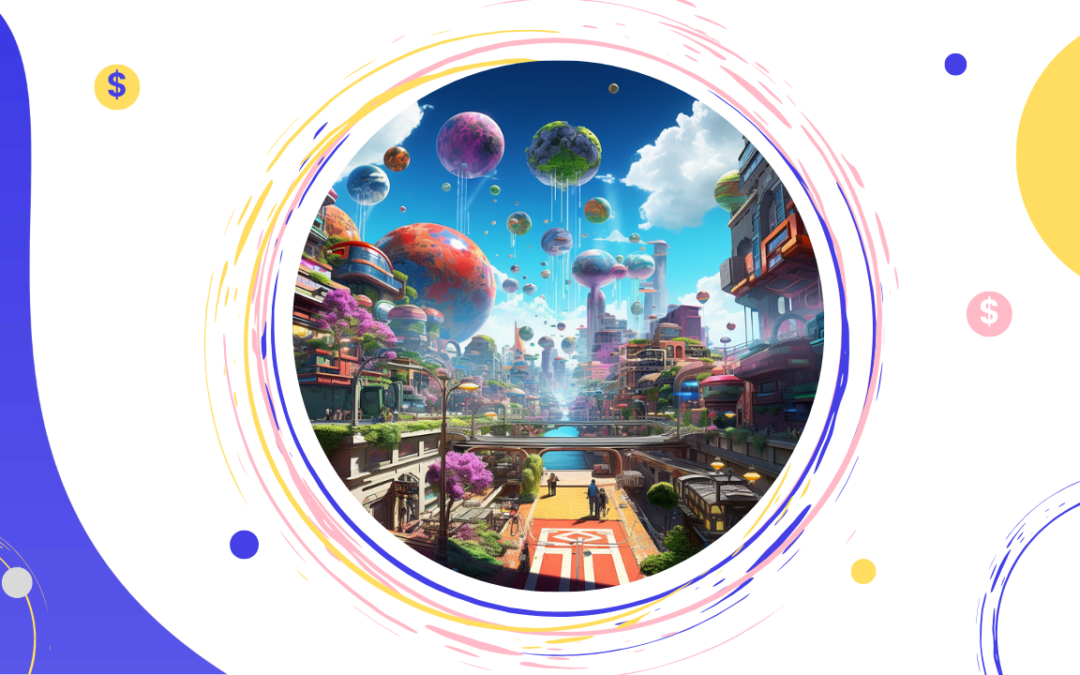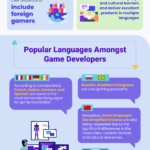In an increasingly globalized world, the gaming industry is no exception to the trend of international expansion. As game developers aim to reach broader audiences, one aspect has become crucial to their success: game localization. But what exactly is game localization or game translation, and why is it so important?
Game localization goes beyond the realm of mere language translation. It’s an art and a science intertwined in the act of tailoring a game’s content to sync with diverse global markets. We’re talking not just text but also the cultural nuances and references that breathe life into a game.
This potent tool is not just an add-on but a game-changer, capable of amplifying the player experience. It’s about creating accessibility, escalating enjoyment, and establishing relatability for gamers across the globe. It’s about transforming your game into a universal passport, making it a home away from home for players, no matter where they are.
Game localization, when executed effectively, acts as a potent revenue booster for your game. It’s about carving your game to perfectly fit the mold of local preferences. It enables developers to pierce through untouched markets, swells their player base, and in turn, elevate their sales.
In this enticing blog post, we are all set to navigate the intricate labyrinth of game localization. We will unfurl the process, dissect the challenges, spotlight successful case studies, and analyze its ripple effect on player experience and revenue. This is your go-to guide whether you’re a game developer eyeing global horizons or a passionate gamer seeking a peek into the backstage of game creation. Buckle up as we traverse the mesmerizing world of game localization.
Table of contents
What do you mean by Game Localization?

Game localization, in essence, is an exhaustive process that tweaks a video game to cater to the cultural, linguistic, and technical expectations of a specific demographic. This procedure goes beyond mere translation of the game’s text – it involves modifying diverse elements such as graphics, audio, cultural allusions, and even hardware compatibility, to resonate with players across varying geographies.
Let’s say, a game brewed in Japan might be steeped in Japanese cultural nuances, language idiosyncrasies, or historical references that might baffle players in other countries. Video game localization steps in here, adapting or swapping these elements to craft a gaming experience that’s both relatable and entertaining for the target language.
Why is global localization important?
The global gaming industry is a multi-billion dollar sector that continues to grow year after year. As more people around the world gain access to gaming platforms and high-speed internet, the potential audience for video games is expanding rapidly.
In this context, game localization has become a vital strategy for game developers seeking to tap into these emerging markets. By localizing their games, developers can make their games more accessible and appealing to a global audience, thereby increasing their potential player base.
Game localization, indeed, can tremendously uplift the player experience. A finely localized game allows players to deeply engage in the game’s universe, eliminating distractions or confusion caused by alien cultural references or clumsy translations. This comprehensive immersion can catalyze heightened player contentment, foster increased player retention, and stimulate positive word-of-mouth, collectively propelling a game’s market success.
Furthermore, game localization can be a significant revenue amplifier. By penetrating new markets, developers can broaden their sales horizon and revenue potential. In fact, numerous prosperous games have reaped a substantial chunk of their revenue from overseas markets, courtesy of efficient localization.
Understanding Game Localization
How does Game Localization Work?

Game localization is an intricate process tailored towards making a video game perfectly accessible, engaging, and pleasurable for players across various cultural backdrops. It isn’t merely about language translation – it’s about moulding the game into a form that wholly resonates with players from different cultural landscapes.
When we discuss localization, we’re addressing a comprehensive procedure encapsulating several pivotal components:
Language Translation
Certainly, the most apparent aspect of localization. It involves translating the game’s textual content, encompassing dialogue, user interface elements, and in-game documentation, into the local language. However, it transcends literal translation, focusing on preserving the same tone, humor, and context in the translated content.
Cultural Adaptation
Games often feature cultural references, idioms, humor, and societal norms distinctive to their development culture. These elements may not translate effectively or might even be offensive in other cultures. Cultural adaptation is about recognizing these elements and modifying them to align with the target culture.
Technical Adaptation
This entails adapting the game to fulfill the technical requirements of the target market, which could include changes to the game’s hardware compatibility, software prerequisites, or even gameplay mechanics.
Legal Compliance
Different nations uphold different laws and regulations about content, privacy, and data handling. Game localization ensures that the game is in strict compliance with all pertinent laws and regulations in the target market.
Graphic and Audio Localization
This process adapts the game’s graphics, artwork, and audio to harmonize with the target market. It might involve alterations to character designs, color schemes, music, and sound effects.
Market-Specific Changes
Occasionally, localization entails implementing changes to the game that specifically cater to a particular market. For instance, a game might incorporate additional content or features designed to captivate players in a specific region.
In a nutshell, game localization is about recreating a version of the game that feels as if it was originally crafted for the target market. It’s a complex and multifaceted process demanding a profound understanding of both the source and target cultures, alongside a high level of technical prowess. However, when executed effectively, it can remarkably enhance the player experience and bolster the game’s global market success.
Game Translation and Localization: Your Key to Global Gaming Glory

So, you’ve heard of video game translation and game localization, right? These terms are often swapped around like they’re the same thing. But guess what? They’re not! They’re two peas in a pod, part of the same family, but each plays a distinct role in connecting your game to players across the globe.
Game Translation: The Language Link
Game translation is that bridge between your game and players who speak a different language. It’s the art of converting every bit of your game’s text, from thrilling dialogues to tiny user interface details, into a language that your international players can understand.
But here’s the thing – it’s not just about swapping words from one language to another. Game translation is about carrying the heart and soul of your game – its tone, humor, and context – across the language barrier. It’s a craft that demands not only linguistic expertise but also a deep dive into the game’s narrative and context.
Game Localization: The Cultural Conduit
Now, game localization? That’s the full package! It covers translation, sure, but it goes much, much further. Picture this: You’re adapting every aspect of your game – artwork, character designs, sound effects, even gameplay mechanics – so it’s in tune with the cultural norms and preferences of your target market. In the process, you might find you need to modify or even remove any content that the player base misinterprets or deems inappropriate in a different culture.
But that’s not all. Localization also requires technical finesse. It’s about ensuring that your game runs smoothly on local hardware and software, while also complying with all the legal standards in your target market. It’s like your game’s passport, ensuring it’s welcome wherever it lands.
In essence, game translation makes your game understandable, but game localization makes it feel homegrown. So, you’re not just crossing the language barrier; you’re bridging cultural divides and opening your game to a world of potential. That’s the power of game localization!
The Role of Culture in Game Localization
Every game is a virtual canvas, painted with the colors of the culture it originates from. Be it the storyline, the humor, the character idioms, or even the societal norms subtly woven into the gameplay – games, like all forms of media, are mirrors reflecting their cultural origins. Now, that’s where the magic of game localization comes in. And within that magic, understanding the culture of your target market takes the front seat.
Cultural Appropriateness: A Game-Changer
Picture this: Your game is a smashing success in your home country. You’ve got players raving about the innovative gameplay, the gripping storyline, and the in-game humor. Now you decide to go global, but oops – what worked at home doesn’t click abroad. What went wrong?
The simple answer: cultural differences. The humor might fall flat, the idioms might be puzzling, or worse, some content might be offensive in a different culture. In the global gaming arena, cultural appropriateness is the real game-changer. A miss here could make your game a no-go in a new market.
Making the Cultural Connection
Understanding the culture of your target market is like unlocking a secret door to your players’ world. It helps you see your game through their eyes, understand their norms, their preferences, and their red lines. It’s about adapting your game to not just speak their language, but to also think their thoughts, laugh at their jokes, and respect their boundaries.
In essence, it’s about turning your game into a culturally immersive experience that your players can relate to, appreciate, and, most importantly, enjoy!
The Process of Game Localization

A. Pre-localization Analysis
- Understanding the Target Audience: Before the localization process begins, it’s important to understand who the target audience is. This includes their age, gaming preferences, cultural background, and language proficiency. This information helps guide the localization process and ensures that the game is tailored to the audience’s preferences and expectations.
- Cultural Research: This involves researching the cultural, societal, and legal norms of the target market. This research helps identify any potential issues that might arise during localization and guides the adaptation of the game’s content.
B. Translation
- Text Translation: This involves translating all the game’s text, including dialogue, on-screen text, and user interface elements, into the local language. This process requires not only language proficiency but also a deep understanding of the game’s context and narrative.
- Voice-over Translation: If the game includes voice acting, the dialogue will need to be translated and re-recorded in the local language. This process often involves hiring local voice actors and ensuring that the translated dialogue maintains the original tone and emotion.
C. Culturalization
- Adapting Cultural References: This involves identifying and adapting any cultural references in the game that may not be understood or may be inappropriate in the target culture. This could include references to history, pop culture, religion, or societal norms.
- Modifying Game Elements to Suit Local Tastes: This could involve changes to the game’s artwork, character designs, music, sound effects, and even gameplay mechanics to align with the preferences and expectations of the local audience.
D. Localization Quality Assurance
- Linguistic Testing: This involves testing the translated text for any errors or inconsistencies. It also includes checking that the text fits within the game’s user interface and doesn’t disrupt the gameplay.
- Cultural Testing: This involves testing the game with local players to ensure that it is culturally appropriate and resonates with the local audience.
- Functionality Testing: This involves testing the game’s functionality to ensure that the localization process hasn’t introduced any bugs or issues.
IV. What are challenges in Game Localization?

A. Linguistic Challenges
These include dealing with language-specific issues such as text expansion, right-to-left languages, and languages with complex grammatical rules. It also includes ensuring that the translated text maintains the original tone and context.
B. Cultural Challenges
These include ensuring that the game is culturally appropriate and doesn’t contain any content that could be considered offensive or inappropriate in the target culture. It also involves adapting cultural references so that they resonate with the local audience.
C. Technical Challenges
These include dealing with issues related to text expansion, character encoding, and hardware compatibility. It also involves ensuring that the localized game functions correctly and doesn’t contain any bugs or issues introduced during the localization process.
V. Case Studies of Successful Game Localization
A. Case Study 1: “The Witcher 3: Wild Hunt”

“The Witcher 3: Wild Hunt” is a prime example of successful game localization. Developed by Polish company CD Projekt Red, the game was localized into 15 languages, with full voice-over in 7 of those languages. The localization process involved over 500 voice actors and 950,000 words. Despite the game’s deep roots in Slavic mythology, the game localization team managed to make the game resonate with players around the world, contributing to the game’s global success.
B. Case Study 2: “Overwatch”

Blizzard’s “Overwatch” is another example of successful game localization. The game was localized into 12 languages, with each character in the game having their own voice actor in each language. The localization team worked closely with the game’s writers and designers to ensure that each character’s personality and backstory were accurately conveyed in each language. The game’s successful localization has helped it build a diverse and global player base.
VI. What are the benefits of game localization?

Increased Market Reach
In today’s globalized world, the gaming industry is no longer confined to a single region or market. Players from all around the globe can access and play games, thanks to the internet and digital distribution platforms. However, to fully tap into these global markets, games need to be localized.
By localizing a game, developers can make their game accessible and appealing to players in different regions. This involves not just translating the game’s text, but also adapting the game’s content and presentation to suit the cultural norms and preferences of each market.
For example, a game that has been effectively localized for the Chinese market will not just be translated into Chinese, but will also take into account Chinese cultural norms, societal values, and gaming preferences. This makes the game more appealing to Chinese players, thereby expanding the game’s potential market reach.
Enhanced Player Experience
A well-localized game can significantly enhance the player experience. When a game is localized, players can fully understand and engage with the game’s narrative and gameplay. They can follow the game’s story, understand the game’s mechanics, and fully immerse themselves in the game’s world.
Moreover, localization can also make the game more relatable and enjoyable for players. By incorporating local cultural references, humor, and societal norms, localization can make the game feel more familiar and engaging. This can lead to higher player satisfaction and retention, contributing to the game’s overall success.
Greater Revenue Potential
Localization can also have a significant impact on a game’s revenue potential. By expanding into new markets, developers can increase their potential sales and revenue.
For instance, let’s consider a game that has been successful in the US market. By localizing this game for other markets, such as the Chinese, Brazilian, or Russian markets, the developer can tap into a whole new player base. This can lead to increased sales, as the game can now be sold to players in these markets.
In fact, many successful games have generated a significant portion of their revenue from international markets. For example, the popular game “Fortnite” has been localized into multiple languages and is played by millions of players around the world. This global player base has contributed significantly to the game’s revenue.
In conclusion, localization is not just a tool for making games understandable to international players; it’s a strategic investment that can expand a game’s market reach, enhance the player experience, and increase revenue potential.
VII. Future Trends in Game Localization

The Role of AI in Game Localization
Artificial Intelligence (AI) and machine learning technologies are making significant strides in many fields, including game localization. These technologies can automate some aspects of the localization process, such as initial translation, which can save time and resources. For instance, AI can be trained to translate text, recognize and adapt cultural references, and even test localized games for errors.
However, while AI can handle many tasks, it’s not yet capable of fully understanding and interpreting cultural nuances, humor, and context in the same way a human can. Therefore, human input will still be crucial in the localization process. Localization professionals will need to review and refine AI-generated translations, ensure cultural appropriateness, and maintain the original game’s tone and context. In essence, AI can be a valuable tool in game localization, but it doesn’t replace the need for skilled human localization professionals.
The Growing Importance of Cultural Consultants
As the gaming industry continues to globalize, understanding and respecting different cultures becomes increasingly important. This is where cultural consultants come in. These are experts who have a deep understanding of a specific culture, including its norms, values, history, and societal rules.
Cultural consultants can provide valuable insights during the localization process. They can help identify potential cultural issues, suggest appropriate adaptations, and ensure that the localized game is culturally sensitive and appropriate. As games aim to reach more diverse audiences, the role of cultural consultants is set to become more important.
The Rise of Fan-Based Localization
Fan-based localization, also known as “fanlation,” is a trend where fans of a game volunteer to translate and localize the game for their local market. This often happens for games that have a strong fan base but haven’t been officially localized for various reasons.
Fan-based localization can have several benefits. Fans often have a deep understanding of the game and a strong connection to the game’s community. They can provide translations that are not only accurate but also capture the spirit and tone of the game. Moreover, fan-based localization can help build a stronger connection between developers and their fans, fostering a sense of community and engagement.
However, fan-based localization also has its challenges. It requires coordination and quality control to ensure consistency and accuracy. Moreover, legal issues can arise, as fan-based localization often happens without the official permission of the game developers. Check out our extensive article about the Pros and Cons of Fan Translation.
VIII. Conclusion
Game localization stands as a vital cog in the game development machine. It’s the golden key that opens the doors to wider audience engagement, amplified user experiences, and heightened revenue prospects.
Given the enormity of its implications and potential windfalls, it’s crucial for game developers to dedicate their efforts toward top-notch localization. This process isn’t simply confined to translating the game’s text but extends to tailoring the game’s content and presentation to reflect the cultural nuances and preferences of the target audience.
To wrap up, game localization is far from being an optional extra—it’s an essential ingredient for any game developer with ambitions to make their mark on the global stage of today’s gaming world. By channeling investments into high-quality localization, developers can ensure their games strike a chord with global players, thereby supercharging their probability of skyrocketing success.
SandVox Solutions – Your dedicated game localization agency
Are you seeking to reach global gaming audiences, to breach boundaries of language and culture? Look no further! SandVox Solutions brings a world-class, quality assured game translation service to your fingertips.
We understand the nuances of translating not just the language, but the essence, the emotion, and the cultural intricacies that make your game special. Our seasoned linguists and game enthusiasts team up to transform your content, keeping it as engaging and exhilarating in a foreign language as it is in its original form.
But we’re not just about words. SandVox Solutions works to ensure every joke lands, every reference is understood, and every gameplay instruction is crystal clear, regardless of who’s playing and where they’re playing from.
We’re committed to the success of your game in the global marketplace. And when you work with us, you’re not just expanding your player base—you’re providing an immersive and enjoyable gaming experience to gamers worldwide.
So, what are you waiting for? Step into the world of SandVox Solutions today. Your global gaming success story is just a translation away!






